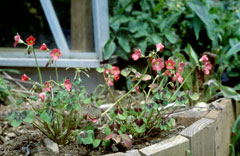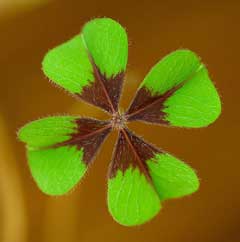 |
|
(c) 2010 Ken Fern & Plants For A Future |
 |
| http://commons.wikimedia.org/wiki/User:Wouterhagens |
Translate this page:
Summary
Physical Characteristics

 Oxalis deppei is a BULB growing to 0.3 m (1ft) by 0.1 m (0ft 4in).
Oxalis deppei is a BULB growing to 0.3 m (1ft) by 0.1 m (0ft 4in).
See above for USDA hardiness. It is hardy to UK zone 8 and is frost tender. It is in flower from June to November. The species is hermaphrodite (has both male and female organs) and is pollinated by Insects.
Suitable for: light (sandy) and medium (loamy) soils and prefers well-drained soil. Suitable pH: mildly acid and neutral soils. It cannot grow in the shade. It prefers moist soil.
UK Hardiness Map
US Hardiness Map
Synonyms
Plant Habitats
Cultivated Beds;
Edible Uses
Edible Parts: Flowers Leaves Root
Edible Uses:
Leaves and flowers - raw or cooked[2, 37, 183]. A delicious lemony flavour, the leaves are tender and fairly free of fibres even when they get older[K]. Both the leaves and the flowers make a very refreshing and thirst-quenching munch in the garden, they also make an excellent flavouring in salads[K]. The leaves are available from June to October and the flowers from July to October, or even later in mild autumns[K]. Use in moderation, see notes at top of sheet. Root - raw or cooked[1, 2, 27, 37, 183]. The roots are up to 10cm long and 3cm wide at the top, they are tender and juicy but usually insipid[K]. Occasionally the root has a pleasant acid flavour, we have yet to find out what causes the difference[K].
References More on Edible Uses
Medicinal Uses
Plants For A Future can not take any responsibility for any adverse effects from the use of plants. Always seek advice from a professional before using a plant medicinally.
None known
References More on Medicinal Uses
The Bookshop: Edible Plant Books
Our Latest books on Perennial Plants For Food Forests and Permaculture Gardens in paperback or digital formats.

Edible Tropical Plants
Food Forest Plants for Hotter Conditions: 250+ Plants For Tropical Food Forests & Permaculture Gardens.
More

Edible Temperate Plants
Plants for Your Food Forest: 500 Plants for Temperate Food Forests & Permaculture Gardens.
More

More Books
PFAF have eight books available in paperback and digital formats. Browse the shop for more information.
Shop Now
Other Uses
References More on Other Uses
Cultivation details
An easily grown plant, preferring a sandy soil in a warm dry position[1, 27, 37]. It dislikes dry or heavy soils[37]. Dislikes lime[37]. Prefers a southerly aspect[37]. This species is only hardy outdoors in the milder areas of Britain, tolerating temperatures down to about -5°c or perhaps a bit lower if the soil is very well-drained. The bulbs are easily harvested in late autumn, however, and can be stored overwinter in a cool frost free place, replanting them in the spring[K]. In milder winter areas a good mulch is usually sufficient to see the bulbs through the winter and they will then normally be more productive of leaves and flowers in the following year. Plants have survived the winter for several years without a mulch on our trial grounds in Cornwall[K]. A very ornamental plant, flowering freely all summer[1, K]. It was formerly cultivated in Mexico for its edible tuber[46] (this may be a mistaken entry that should have referred to O. tuberosa. Whilst the root of this plant is edible it is neither productive nor very flavourful. The leaves and the flowers are far superior[K]). This species is closely related to and probably part of O. tetraphylla[200], differing only in its sessile bulbils and truncate leaves[50].
References Carbon Farming Information and Carbon Sequestration Information
Temperature Converter
Type a value in the Celsius field to convert the value to Fahrenheit:
Fahrenheit:
The PFAF Bookshop
Plants For A Future have a number of books available in paperback and digital form. Book titles include Edible Plants, Edible Perennials, Edible Trees,Edible Shrubs, Woodland Gardening, and Temperate Food Forest Plants. Our new book is Food Forest Plants For Hotter Conditions (Tropical and Sub-Tropical).
Shop Now
Plant Propagation
Seed - best sown as soon as ripe in a cold frame. Prick out the seedlings into individual pots when they are large enough to handle and plant them out in late spring or early summer. Our plants have never produced seed. Division in autumn, harvest the bulbs and replant in the spring. They usually increase very freely.
Other Names
If available other names are mentioned here
Native Range
Coming Soon
Weed Potential
Right plant wrong place. We are currently updating this section.
Please note that a plant may be invasive in one area but may not in your area so it's worth checking.
Conservation Status
IUCN Red List of Threatened Plants Status :

Growth: S = slow M = medium F = fast. Soil: L = light (sandy) M = medium H = heavy (clay). pH: A = acid N = neutral B = basic (alkaline). Shade: F = full shade S = semi-shade N = no shade. Moisture: D = dry M = Moist We = wet Wa = water.
Now available:
Food Forest Plants for Mediterranean Conditions
350+ Perennial Plants For Mediterranean and Drier Food Forests and Permaculture Gardens.
[Paperback and eBook]
This is the third in Plants For A Future's series of plant guides for food forests tailored to
specific climate zones. Following volumes on temperate and tropical ecosystems, this book focuses
on species suited to Mediterranean conditions—regions with hot, dry summers and cool, wet winters,
often facing the added challenge of climate change.
Read More
Expert comment
Author
Loddiges.
Botanical References
200
Links / References
For a list of references used on this page please go here
Readers comment